Linden D., Reddy T.B. (eds.) Handbook of batteries
Подождите немного. Документ загружается.


23.66 CHAPTER TWENTY-THREE
TABLE 23.17a Typical Stationary Batteries, Flat-Pasted Plates
Positive-
plate
capacity,
Ah at
8-h rate
Plate dimensions, mm
Height Width
Thickness
Positive Negative
Cell size*†
(positive
plates
per cell)
5 89 63.5 6.6 4.3 2,4
25 149 143 6.6 4.3 1–8
90–95 290 222 7.9 5.3 2–12
150–155 381 304 6.4 4.6 2–17
166 381 304 7.9 5.3 5–16
195 457 338 6.9 5.3 13–18
412 1816 338 7.6 5.5 17–19
*Typical cell construction: n positive and n ⫹ 1 outside negative plates per cell. Some smaller cell sizes are
assembled in multiples of two, three, or four cells in a monolithic container.
†Typical cell characteristics: 10 positive 168-Ah plates (1680-Ah cell); weight: 140 kg; size: length, 270 mm; width,
359 mm; height, 575 mm.
Source: C & D Technologies, Inc., Blue Bell, Pa.
TABLE 23.17b Typical Stationary Batteries, Tubular Plates
Positive-plate
capacity, Ah
At 4-h
rate
At 8-h
rate
Plate dimensions, mm
Height Width
Thickness
Positive Negative
Cell size*†
(positive
plates
per cell)
26 31.25 157 203 8.9 5.6 4
76 96 277P 234P 8.9 3–10
290N 239N 6.1
88 105 277P 234P 8.9 3–10
290N 239N 6.1
124 152 366 307 8.9 4.8 5–14
*Typical cell construction: n positive and n ⫹ 1 outside negative plates per cell; used with flat-pasted negative
plates.
†Typical cell characteristics: 11 positive 152-Ah plates (1672-Ah cell); weight: 128 kg; size: length, 272 mm; width,
368 mm; height, 577 mm.
Source: Enersys, Inc., and Tudor AB.

LEAD-ACID BATTERIES 23.67
TABLE 23.17c Typical Stationary Batteries, Plante´ Plates
Positive-plate
capacity,
Ah at
8-h rate
Plate dimensions, mm
Height Width
Thickness
Positive Negative
Cell size*
(positive
plates
per cell)
Plante´ type†‡
8 140 140 9.5 4.7 3, 5, 7
20 9.5 4.7 5–17
40 11.1 9–25
80 286 233 9.5 4.7 2–7
83 11.1 13–25
Manchester type†§
20 155 149 9.7 4.6 2, 3, 4
40 197 197 11.2 4.6 2–9
83 282 292 11.2 4.6 5–12
*Typical cell construction: n positive and n ⫹ 1 negative outside plates per cell.
†Used with flat-pasted negative plates.
‡Typical Plante´ cell characteristics: 2 positive 80-Ah plates (160-Ah cell). Two-cell battery size: L 283 mm, W 159
mm, H 463 mm.
Source: Gould, Inc.
§Typical Manchester cell characteristics: 4 positive 40-Ah plates (160-Ah cell). One-cell battery weight: 40 kg; size:
length, 131 mm; width, 257 mm; height, 455 mm.
Source: Enersys, Inc.
23.7 CHARGING AND CHARGING EQUIPMENT
23.7.1 General Considerations
In the charging process, DC electric power is used to reform the active chemicals of the
battery system to their high-energy, charged state. In the case of the lead-acid battery, this
involves, as shown in Sec. 23.2, the conversion of lead sulfate in the positive electrodes to
lead oxide (PbO
2
), the conversion of lead sulfate of the negative electrode to metallic lead
(sponge lead), and the restoration of the electrolyte from a low-concentration sulfuric acid
solution to the higher concentration of approximately 1.21 to 1.30 specific gravity. Since a
change of phase from solid to solution is involved with the sulfate ion, charging lead-acid
batteries has special diffusional considerations and is temperature-sensitive. During charge
and discharge the solid materials which go into solution as ions are reprecipitated as a
different solid compound. This also causes a redistribution of the active material. The rear-
rangement will tend to make the active material contain a crystal structure with fewer defects,
which results in less chemical and electrochemical activity. Therefore the lead-acid battery
is not as reversible physically as it is chemically.
29
This physical degradation can be mini-
mized by proper charging, and often batteries discarded as dead can be restored with a long,
slow recharge (3 to 4 days at 2 to 3 A for SLI batteries).
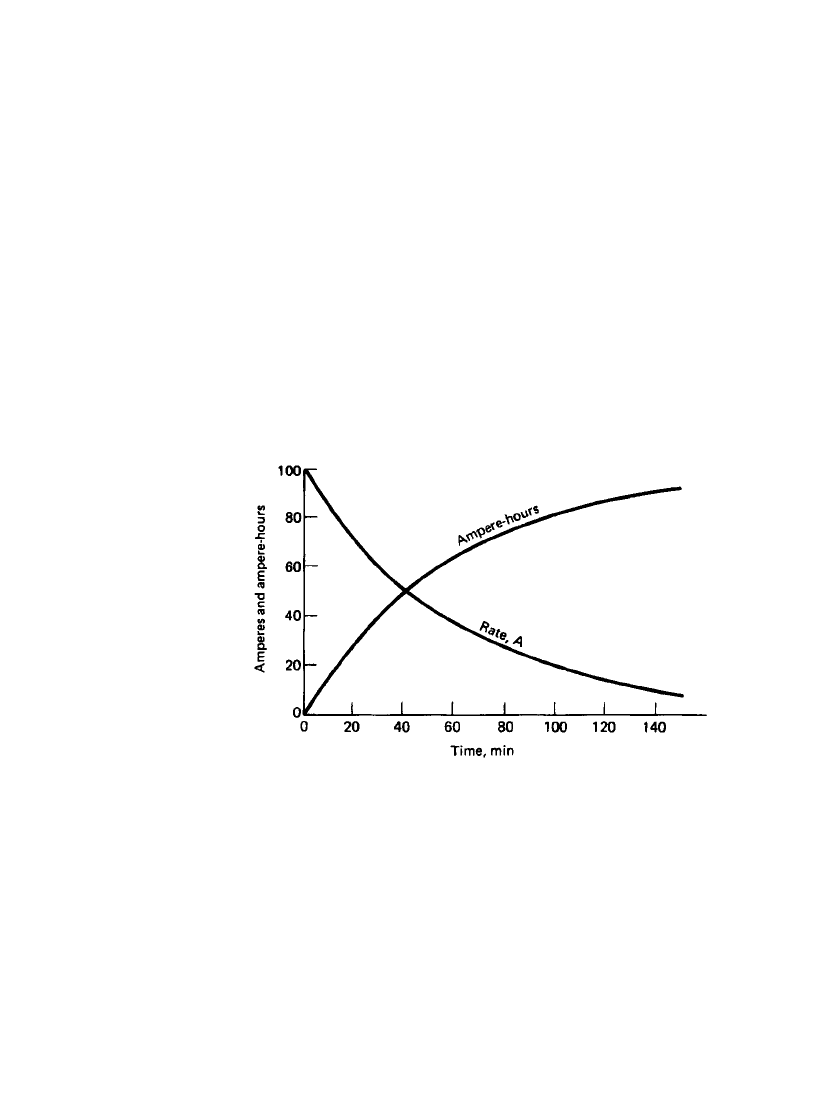
23.68 CHAPTER TWENTY-THREE
A lead-acid battery can generally be charged at any rate that does not produce excessive
gassing, overcharging, or high temperatures. The battery can absorb a very high current
during the early part of the charge, but there is a limit to the safe current as the battery
becomes charged. This is shown in Fig. 23.45, which is a graphic representation of the
Ampere-hour rule
⫺
t
I ⫽ Ae
where I is the charging current, A is the number of Ampere-hours previously discharged
from the battery, and t equals time. Because there is considerable latitude, there are a number
of charging regimes, and the selection of the appropriate method depends on a number of
considerations, such as the type and design of the battery, service conditions, time available
for charging, number of cells or batteries to be charged, and charging facilities. Figure 23.46
shows the relation of cell voltage to the state of charge and the charging current. The figure
shows that a fully discharged battery can absorb high currents with the charging voltage
remaining relatively low. However, as the battery becomes charged, the voltage increases to
excessively high values if the charge is maintained at the high rate, leading to overcharge
and gassing. The charge current should be reduced to reasonable values at the battery reaches
full charge.
FIGURE 23.45 Graphic illustration of ampere-hour law. (From
Vinal.
18
)
In automotive, marine, and other vehicle applications, the DC electric power is usually
provided by an on-board generator or alternator driven from the prime engine. These devices
have a voltage and current limiter to prevent overcharging. The proper limit is dependent on
the chemistry and physical construction of the cell or battery. For the traditional automotive
batteries which use antimonial lead alloy as grid material, voltage limits in the range of 14.1
to 14.6 V for a nominal 12-V battery are usual. With the newer maintenance-free batteries,
which use a calcium-lead alloy grid or other grid material with high hydrogen overvoltage,
higher charging voltages, in the range of 14.5 to 15.0 V, can be used without danger of
overcharge. Batteries in automobile and similar applications today see what is close to cy-
cling rather than float service, but the charging controls are such that very little gas is evolved
on charge. This minimizes the requirement for watering, but makes accurate control of the
charge necessary. The charging rates for the different types of SLI batteries are compared
in Fig. 23.47.
9
The calcium-lead maintenance-free battery is less affected by high settings
in the voltage regulator than the other batteries.
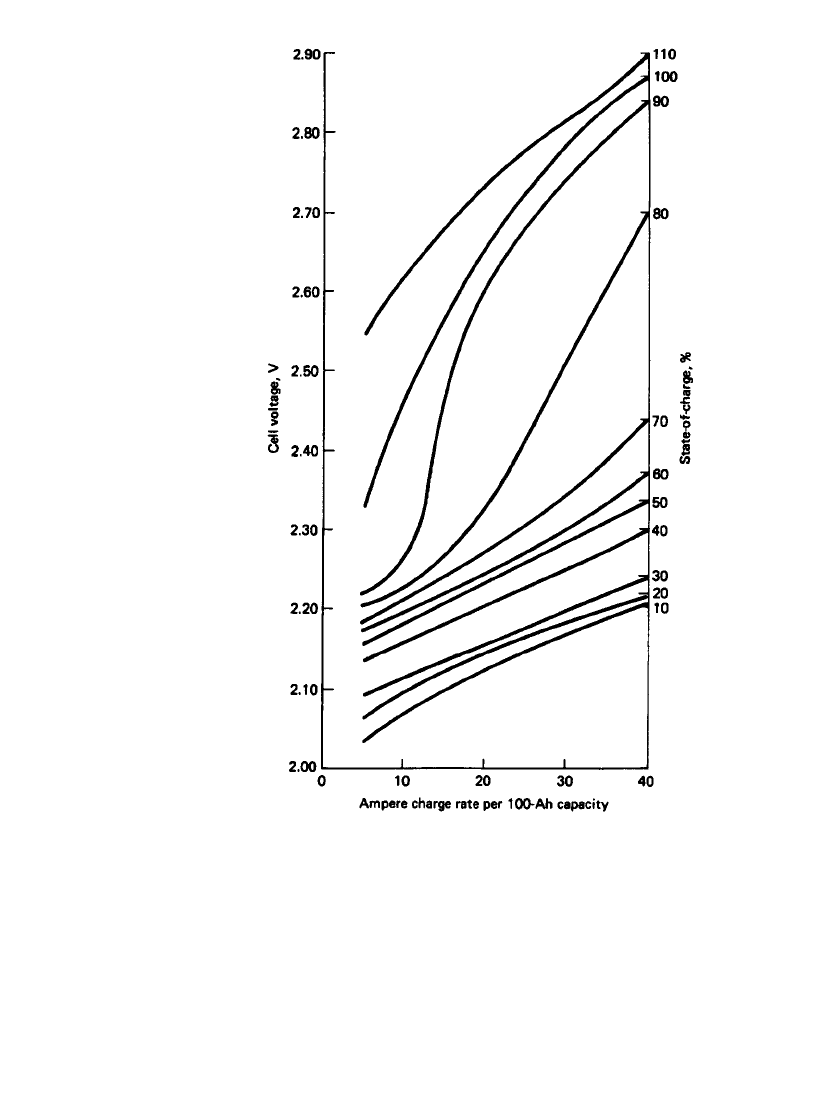
LEAD-ACID BATTERIES 23.69
FIGURE 23.46 Charging voltage of lead-acid battery at various
states of charge. (From Ref. 23.)
In many nonautomotive applications, charging is done separately from the system using
the battery. The direct current necessary for charging is usually obtained by rectifying alter-
nating current. These chargers include wall-hung units and mobile units as well as floor-
mounted units. Newer charger designs have microprocessor controls, can sense battery con-
dition, temperature, voltage, charge current, and so on, and are capable of changing charging
rates during the charge. Most rectifiers produce some AC ripple with the direct current,
which causes additional heating of the battery. This should be minimized, especially near
the end of the charge when batteries tend to get hot. Pulse charging and the use of asymmetric
alternating current have been proposed as a means to overcome this problem, but practical
lead-acid batteries have such large capacitances that the pulses are smoothed out and the
effects minimized.
29
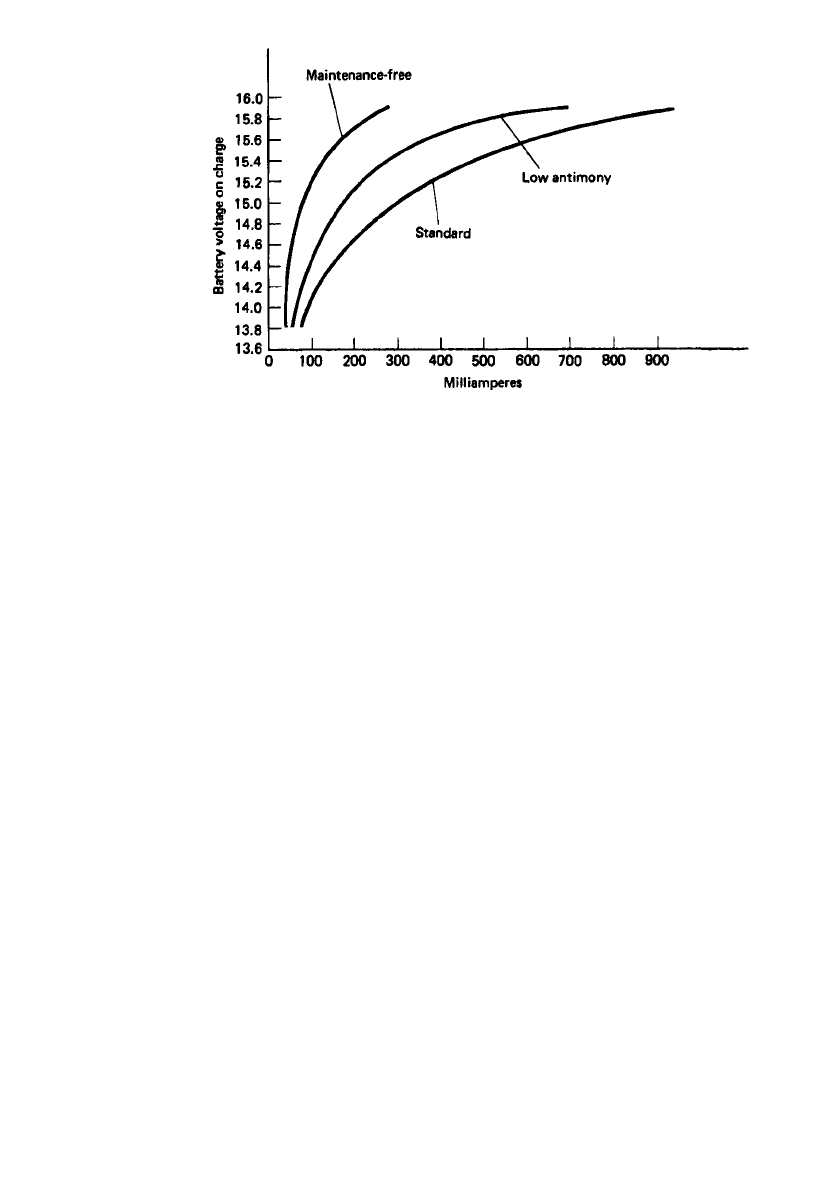
23.70 CHAPTER TWENTY-THREE
FIGURE 23.47 Charging characteristics of lead-acid SLI batteries at 25⬚C.
23.7.2 Methods of Charging Lead-Acid Batteries
Proper recharging is important to obtain optimum life from any lead-acid battery under any
conditions of use. Some of the rules for proper charging are given below and apply to all
types of lead-acid batteries.
1. The charge current at the start of recharge can be any value that does not produce an
average cell voltage in the battery string greater than the gassing voltage (about 2.4 V
per cell).
2. During the recharge and until 100% of the previous discharge capacity has been returned,
the current should be controlled to maintain a voltage lower than the gassing voltage. To
minimize charge time, this voltage can be just below the gassing voltage.
3. When 100% of the discharged capacity has been returned under this voltage control, the
charge rate will have normally decayed to the charge ‘‘finishing’’ rate. The charge should
be finished at a constant current no higher than this rate, normally 5 A per 100 Ah of
rated capacity (referred to as the 20-h rate).
A number of methods for charging lead-acid batteries have evolved to meet these con-
ditions. These charging methods are commonly known as:
1. Constant-current, one-current rate
2. Constant-current, multiple decreasing-current steps
3. Modified constant current
4. Constant potential
5. Modified constant potential with constant initial current
6. Modified constant potential with a constant finish rate
7. Modified constant potential with a constant start and finish rate
8. Taper charge
9. Pulse charging
10. Trickle charging
11. Float charging
12. Rapid charging
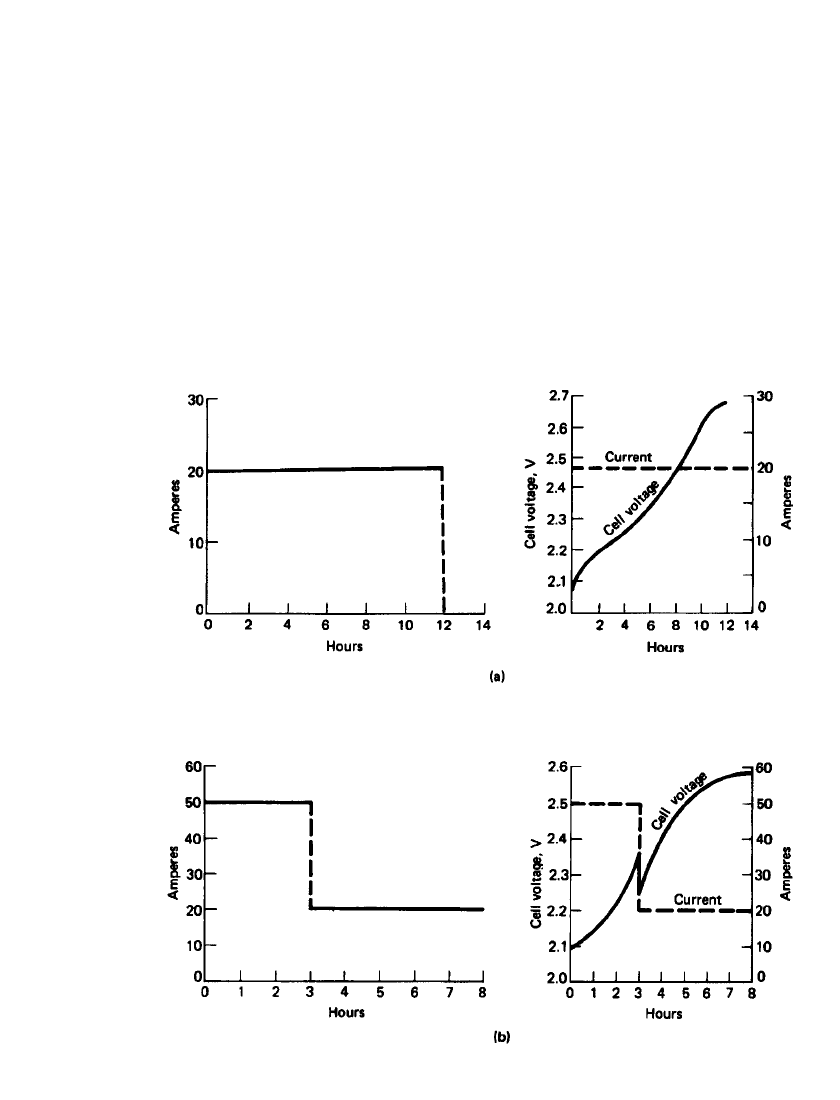
LEAD-ACID BATTERIES 23.71
FIGURE 23.48 Typical charger and battery characteristics for constant-current charging of
lead-acid batteries. (a) Single-step constant-current charging. (b) Two-step constant-current
charging. (From Ref. 10.)
Constant-Current Charging. Constant-current recharging, at one or more current rates, is
not widely used for lead-acid batteries. This is because of the need for current adjustment
unless the charging current is kept at a low level throughout the charge (Ampere-hour rule),
which will result in long charge times of 12 h or longer. Typical charger and battery char-
acteristics for the constant-current charge, for single and two-step charging, are shown in
Fig. 23.48.
Constant-current charging is used for some small lead-acid batteries (see Chap. 24). The
use of a constant-current charge during the initial battery ‘‘formation’’ charge has been de-
scribed in Sec. 23.3. Constant-current charging is also used at times in the laboratory because
of the convenience of calculating Ampere-hour input and because constant-current charging
can be done with simple, inexpensive equipment. Constant-current charging at half the 20-
h rate can be used in the field to decrease the sulfation in batteries which have been over-
discharged or undercharged. This treatment, however, may diminish battery life and should
be used only with the advice of the battery manufacturer.
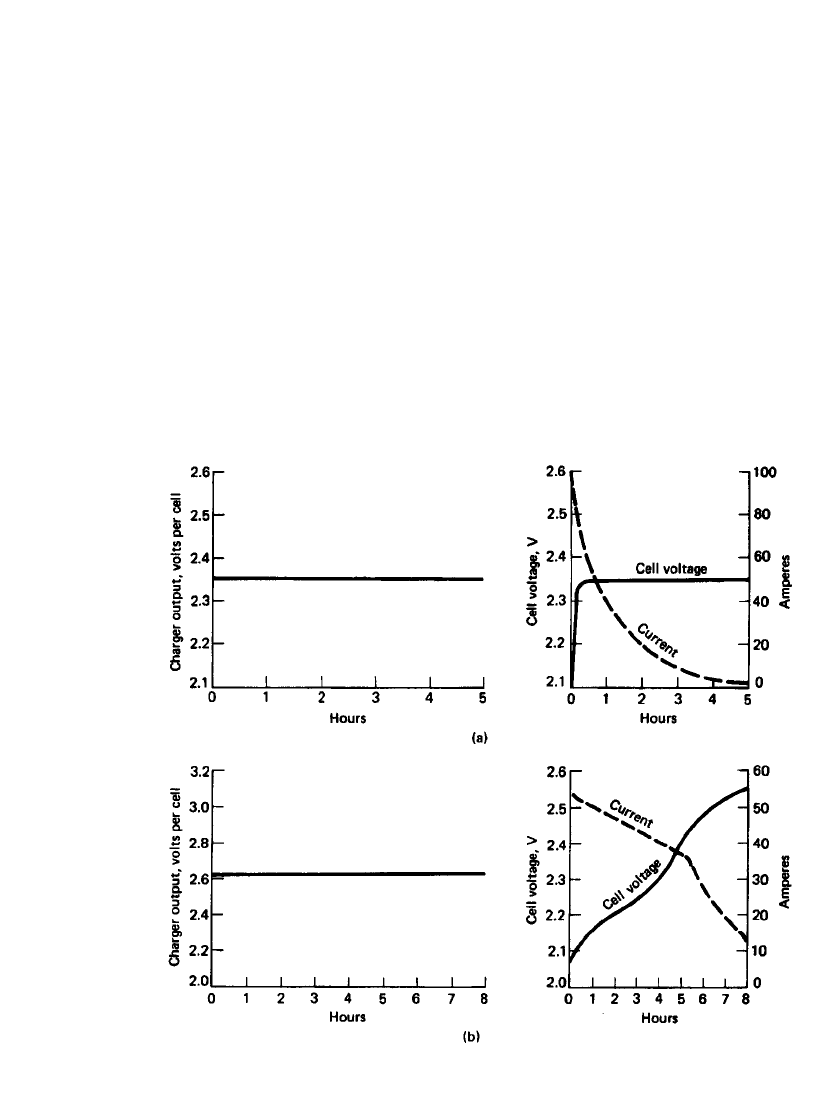
23.72 CHAPTER TWENTY-THREE
FIGURE 23.49 Typical charger and battery characteristics for constant-potential charging of
lead-acid batteries. (a) Constant-potential charging. (b) Modified constant-potential charging.
(From Ref. 10.)
Constant-Potential Charging. The characteristics of constant-potential and modified con-
stant-potential charging are illustrated in Fig. 23.49. In normal industrial applications, mod-
ified constant-potential charging methods are used (methods 5, 7, and 8). Modified constant-
potential charging (method 5) is used for on-the-road vehicles and utility, telephone, and
uninterruptible power system applications where the charging circuit is tied to the battery.
In this case the charging circuit has a current limit, and this value is maintained until a
predetermined voltage is reached. Then the voltage is maintained constant until the battery
is called on to discharge. Decisions must be made regarding the current limit and the con-
stant-voltage value. This is influenced by the time interval when the battery is at the constant
voltage and in a 100% state of charge. For this ‘‘float’’-type operation with the battery always
on charge, a low charge current is desirable to minimize overcharge, grid corrosion associated
with overcharge, water loss by electrolysis of the electrolyte, and maintenance to replace
this water. To achieve a full recharge with a low constant potential requires the proper
selection of the starting current, which is based on the manufacturer’s specifications.
The modified constant-potential charge, with constant start and finish rates, is common
for deep-cycling batteries which are typically discharged at the 6-h rate to a depth of 80%;
the recharge is normally completed in an 8-h period. The charger is set for the constant
potential of 2.39 V per cell (the gassing voltage), and the starting current is limited to 16 to
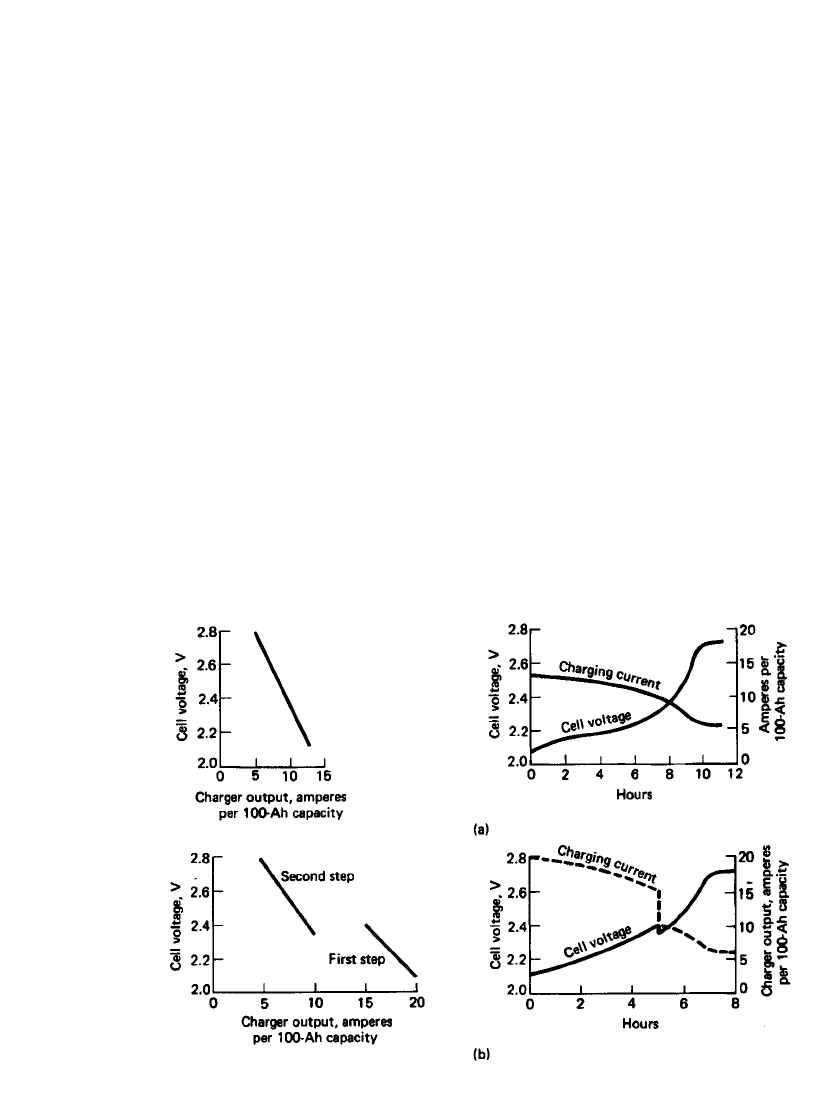
LEAD-ACID BATTERIES 23.73
FIGURE 23.50 Typical charger and battery characteristics for taper charging of lead-acid
batteries. (a) Single-step taper charge. (b) Two-step taper charge. (From Ref. 10.)
20 A per 100 Ah of the rated 6-h Ampere-hour capacity by means of a series resistor in the
charger circuit. This initial current is maintained constant until the average cell voltage in
the battery reaches 2.39 V. The current decays at constant voltage to the finishing rate of
4.5 to 5 A per 100 Ah, which is then maintained to the end of the charge. Total charge time
is controlled by a timer. The time of charge is selected to ensure a recharge input capacity
of a predetermined percent of the Ampere-hour output of the previous discharge, normally
110 to 120%, or 10 to 20% overcharge. The 8-h charging time can be reduced by increasing
the initial current limit rate.
Taper Charging. Taper charging is a variation of the modified constant-potential method,
using less sophisticated controls to reduce equipment cost. The characteristics of taper charg-
ing are illustrated in Fig. 23.50. The initial rate is limited, but the taper of voltage and current
is such that the 2.39 V per cell at 25
⬚C is exceeded prior to the 100% return of the discharge
ampere-hours. This method does result in gassing at the critical point of recharge, and the
cell temperature is increased. The degree of gassing and temperature rise is a variable de-
pending on the charger design, and battery life can be degraded from excessive battery
temperature and overcharge gassing (see Sec. 23.8.3). The gassing voltage decreases with
increasing temperature; correction factors given in Table 23.18 provide the voltage correction
factors at temperatures other than 25
⬚C.
The end of the charge is often controlled by a fixed voltage rather than a fixed current.
Therefore when a new battery has a high counter-EMF, this final charge rate is low and the
battery often does not receive sufficient charge within the time period allotted to maintain
the optimum charge state. During the latter part of life when the counter-EMF is low, the
charging rate is higher than the normal finishing rate, and so the battery receives excessive
charge, which degrades life. Thus the taper charge does degrade battery life, which must be
justified by the use of less expensive equipment.

23.74 CHAPTER TWENTY-THREE
TABLE 23.18 Correction Factors for Cell Gassing Voltage
Electrolyte temperature,
⬚C
Cell gassing voltage,
V
Correction factor,
V
50 2.300 ⫺0.090
40 2.330
⫺0.060
30 2.365
⫺0.025
25 2.390 0
20 2.415
⫹0.025
10 2.470
⫹0.080
0 2.540
⫹0.150
⫺10 2.650 ⫹0.260
⫺20 2.970 ⫹0.508
For photovoltaic battery systems and other systems designed for optimum life, charging
control and regulation circuits should produce a pattern of voltage and current equivalent to
the best industrial circuits. Modified constant-potential charging methods with constant initial
current (methods 5 and 7) are preferred. Optimum control to maximize life and energy output
from the battery is best achieved when the depth of discharge and the time for recharge are
predetermined and repetitive, a condition not always realized in solar photovoltaic applica-
tions.
Pulse Charging. Pulse charging is also used for traction applications, particularly in Eu-
rope. In this case the charger is periodically isolated from the battery terminals and the open-
circuit voltage of the battery is automatically measured (an impedance-free measurement of
the battery voltage). If the open-circuit voltage is above a preset value, depending on a
reference temperature, the charger does not deliver energy. When the open-circuit voltage
decays below that limit, the charger delivers a DC pulse for a fixed time period. When the
battery state of charge is very low, charging current is connected almost 100% of the time
because the open-circuit voltage is below the present level or rapidly decays to it. The
duration of the open-circuit and the charge pulses are chosen so that when the battery is
fully charged, the time for the open-circuit voltage to decay is exactly the same as the pulse
duration. When the charger controls sense this condition, the charger is automatically
switched over to the finish rate current and short charging pulses are delivered periodically
to the battery to maintain it at full charge. In many industrial applications high-voltage
batteries may be used and difficulty can be encountered in keeping the cells in a balanced
condition. This is particularly true when the cells have long periods of standby use with
different rates of self-decay. In these applications the batteries are completely discharged and
recharged periodically (usually semiannually) in what is called an equalizing charge, which
brings the whole string of cells back to the complete charge state. On completion of this
process, the liquid levels in the cells must be checked and water added to depleted cells as
required. With the newer types of maintenance-free cells, which are semisealed, such equal-
izing charges and differential watering of the cells may not be possible, and special precau-
tions are taken in the charger design to keep the cells at an even state of charge.
Trickle Charging. A trickle charge is a continuous constant-current charge at a low (about
C/ 100) rate, which is used to maintain the battery in a fully charged condition, recharging
it for losses due to self-discharge as well as to restore the energy discharged during inter-
mittent use of the battery. This method is typically used for SLI and similar type batteries
when the battery is removed from the vehicle or its regular source of charging energy for
charging.

LEAD-ACID BATTERIES 23.75
Float Charging. Float charging is a low-rate constant-potential charge also used to main-
tain the battery in a fully charged condition. This method is used mainly for stationary
batteries which can be charged from a DC bus. The float voltage for a non-antimonial grid
battery containing 1.210 specific gravity electrolyte and having an open-circuit voltage of
2.059 V per cell is 2.17 to 2.25 V per cell.
Rapid Charging. In many applications, it is desirable to be able to rapidly recharge the
battery within an hour or less. As is the case under any charging condition, it is important
to control the charge to maintain the morphology of the electrode, to prevent a rise in the
temperature, particularly to a point where deleterious side reactions (corrosion, conversion
to nonconducting oxides, high solubility of materials, decomposition) take place, and to limit
overcharge and gassing. As these conditions are more prone to occur during high-rate charg-
ing, charge control under these conditions is critical.
The availability of small, low-cost but sophisticated semiconductor chips has made ef-
fective methods of controlling the charging voltage-current-profile feasible. These devices
can be used to either terminate the charge, limit the charge current, or switch between charge
regimes when potentially damaging conditions arise during the charge.
A number of different techniques have been developed for effective rapid recharge. In
one method, referred to as ‘‘reflex’’ charging, a brief discharge pulse of a fraction of a second,
is incorporated into the charging regime. This technique has been found to be effective in
preventing an excessive rise in temperature during rapid (15-min) high-rate recharging.
23.8 MAINTENANCE SAFETY, AND OPERATIONAL FEATURES
23.8.1 Maintenance
It is common for industrial lead-acid batteries to function for periods of 10 years or longer.
Proper maintenance can ensure this extended useful life. Five basic rules of proper mainte-
nance are:
1. Match the charger to the battery charging requirements.
2. Avoid overdischarging the battery.
3. Maintain the electrolyte at the proper level (add water as required).
4. Keep the battery clean.
5. Avoid overheating the battery.
In addition to these basic rules, as the battery is made of individual cells connected in series,
the cells must be properly balanced periodically.
Charging Practice. Poor charging practice is responsible for short battery life more than
any other cause. Fortunately the inherent physical and chemical characteristics of lead-acid
batteries make control of charging quite simple. If the battery is supplied with DC energy
at the proper charging voltage, the battery will draw only the amount of current that it can
accept efficiently, and this current will reduce as the battery approaches full charge. Several
types of devices can be used to ensure that the charge will terminate at the proper time. The
specific gravity of the electrolyte should also be checked periodically for those batteries that
have a removable vent and adjusted to the specified value (see Tables 23.7 and 23.12).
